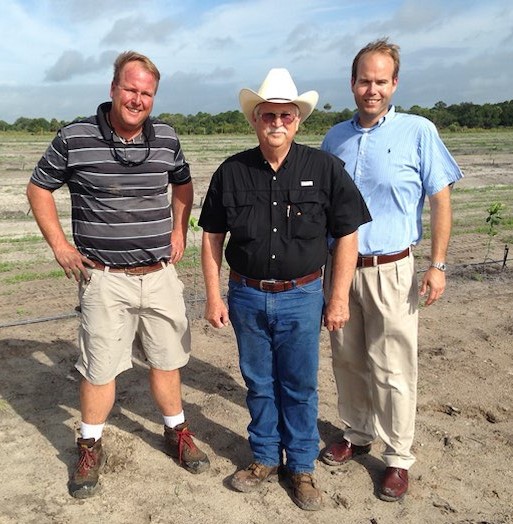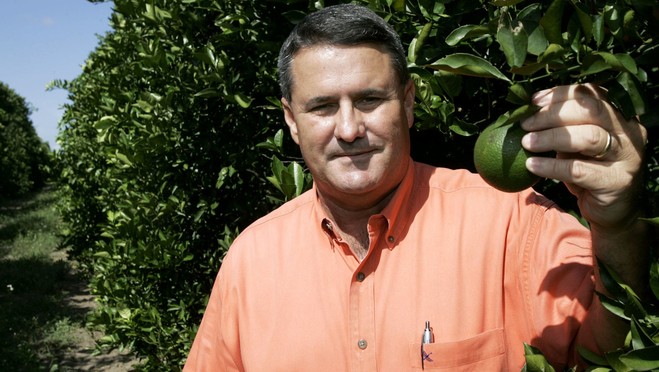OTC Injections and Improved Tree Health Are Instilling Hope in Growers
by PAUL CATALA
The final USDA citrus forecast for Florida’s 2023-24 season turned out to be exactly what growers expected, and that’s not a bad thing. The July report for production of all oranges was up 1 percent from June at 17.96 million boxes and up from last year’s total of 15.9 million boxes.
Even though there was a slight uptick in the total for this year, this season showed growers still struggling and continuing to suffer from the effects of hurricanes and greening.
Any uptick in citrus production in Florida and across Polk County is welcomed by area citrus growers, pickers, packers and lovers.
Here’s a breakdown of the USDA forecast announced July 12:
- All oranges — 17.96 million boxes
- Non-Valencia oranges — 6.76 million boxes
- Valencia oranges — 11.2 million boxes
- All grapefruit — 1.79 million boxes
- Tangerines and tangelo — 450,000 boxes
In comparison, Florida produced 15.9 million boxes of oranges for the 2022-2023 Florida season.
Across the Central Florida citrus community, growers have mixed feelings about the latest forecast.

One of them, Kyle Story, calls the past citrus season relatively difficult for citrus producers statewide.
Story is vice president of The Story Companies. Founded in 1945 and based in Lake Wales, the companies are various Florida-based land-management entities. The family-owned and operated corporations include land holdings, management, marketing and harvesting for more than 5,000 acres of Florida citrus, peaches and blueberries in Central and South Florida.
Story oversees the harvesting and marketing division, as well as investments. He says the recent citrus season was tough for most growers who were recovering from hurricane damage. Hurricane Ian made landfall in Florida in late September of 2022, and Hurricane Nicole made landfall in Florida in early November the same year. In addition, the ongoing fight against citrus greening has compounded growth problems.
“We’ve had positive seasons year over year, but as far as the industry is concerned, I know it was a challenge for most growers,” he says.
Story says he’s seen great improvements in maintaining and expanding trees through new growth therapies over the past season. Those include the use of oxytetracycline (OTC) hydrochloride injections — which fight Candidatus Liberibacter asiaticus, the bacterium that causes the disease Huanglongbing (HLB) in citrus — as well as Citrus Under Protective Screening (CUPS), which shields trees to prevent pests and citrus psyllid/HLB from attacking trees.
The Story Companies is in its second year utilizing tree injections. He says he’s looking for the next generation of trees that will be “greening resistant.”
“We’re seeing very positive signs with the therapies that we’ve deployed, and the trees are definitely responding in a positive way, so that gives us the hope and the desire to keep going forward,” Story says.
OTC injections have been in use across the state for about a year. According to Ute Albrecht, associate professor of plant physiology with UF/IFAS, early results of OTC injections have been mixed. She says some growers are getting positive results and younger trees are responding better than older ones.
An uptick in this season’s citrus harvest indicates overall tree health seems to be improving statewide, says Rick Dantzler, chief operating officer for the Citrus Research and Development Foundation in Lake Alfred. The agency oversees scientific research against citrus greening.
Dantzler says nearly all growers reported an increase in tree health, but not all growers have seen that translate to higher yields. He adds that CRDF researchers predicted it would take two to three years for the full effect of the therapy to kick in and if growers stick with it, “I am confident they will begin seeing more and better fruit.”
In addition, Dantzler says the CRDF is learning more about administering the therapy. For example, he says two injections – one on each side of the tree at the same time – work better than one even though the same amount of active ingredient is used and “distribution throughout the canopy is much greater.”
“We also have seen an increase in root growth for trees treated with OTC, which will translate into higher yields because HLB is, at its core, a root disease,” he says. “Better yields will follow increased root health.”
For upcoming citrus seasons, Dantzler says since OTC can only be injected two of three years, the CRDF is looking to find another molecule or compound for growers to use during the “off” year.
“We have had discussions with regulators at the state and federal levels seeking input on various options. It’s too early to tell where this will land, but I predict we will come up with something,” he added.
Dantzler predicts trees will continue to respond to OTC injections, but he adds that so much citrus acreage has been lost he’s unsure how much the total yield will increase.

“I’m certain we are on the right track, though, and that the march back to sustainability and growth has begun,” he says.
Through work and research done by the CRDF, UF/IFAS, and other groups, Matt Joyner, executive vice president and CEO of Florida Citrus Mutual, says the slight increase in citrus production this season was a result of Florida growers’ “unwavering dedication to rebuilding their groves and restoring our state’s signature crop.”
Joyner agrees innovative treatments and new therapies to combat citrus greening have been effective.
“Our work is far from over. Growers, researchers, and industry leaders will continue to replant trees, seek cutting-edge solutions to restore the health of trees and increase production levels to meet consumer demand,” Joyner says. “We’re confident we’ll get there — the future of Florida citrus is full of hope.”

That hope is echoed by Ray Royce, executive director at Highlands County Citrus Growers Association and a citrus grower from 1981 to 2001 who’s represented growers for the past 23 years. He suggests a “wide range of factors” such as greening has caused production to fall dramatically in the last decade, in addition to hurricane damage causing trees to take longer to recover with hundreds of thousands of acres going out of production for various reasons.
Royce adds that growers are committed to growing a quality product although trees impacted by weather along with greening find it harder to recover from any stressor.
“While we have not had the technical final figures, it’s basically the season will end with us picking right at 18 million boxes of oranges. We are hopeful that we have now seen the low point in citrus production. We’re now seeing a slow-but-increasing production in the next several years,” says Royce, who predicts a 2 to 3 percent increase with new trees and therapies for greening.
“I am cautiously optimistic that we will see the crop be slightly larger next year,” he says, adding the citrus industry will never return to the size it was even a decade ago.

Another grower with optimism is Glenn Beck, former president of Florida Citrus Mutual and co-owner and president of Beck Brothers Citrus, home to about 4,000 acres of citrus groves.
He says any gains in citrus output were partly due to no major hurricanes in recent months, although the industry continues to struggle. He says his company does perform trunk injections, which he says is the biggest factor in keeping citrus trees healthy.
“We did make some gains as we continue to lose some acreage, but for the first time in a long time, we have some reason for optimism,” he says, citing the new therapies being employed that have positive effects on tree health.
“We’re hoping we have hit our lowest point and will continue to climb.”

